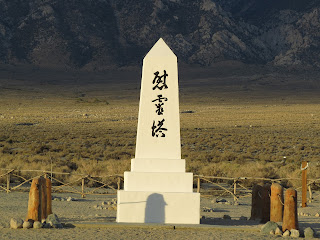 |
| Cemetery obelisk at Manzanar National Historic Site. |
Manzanar National Historic Site is located in the stunningly beautiful Owens Valley of eastern California. Eager to explore the valley as well as learn about its history, Diane and I turned our usual one- to two-week research trip into a two-month road trip with a five-week sojourn in the Owens Valley in the middle. If you have never seen the Owens Valley, see it. If you have not been to Manzanar, go. The camp that once held 10,000 people is now a World War II-era ghost town with remnants of Japanese gardens excavated from sand drifts and rabbit brush growing up through cracked cement pads. The 1944 high school auditorium building has been renovated into a first-class visitor center and museum. The place is blessed with an exceptionally dedicated staff.